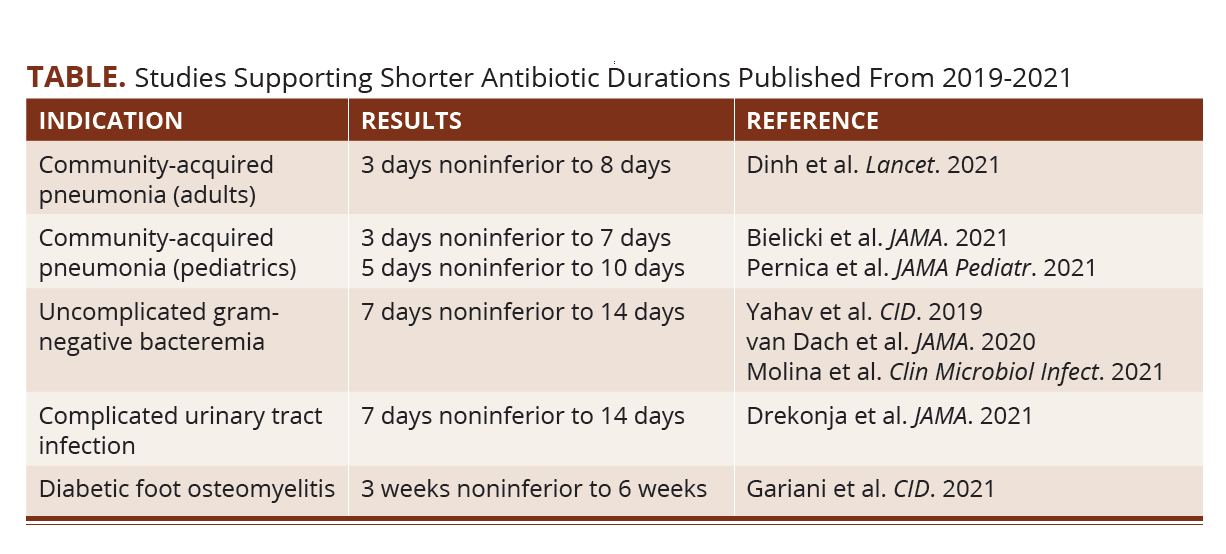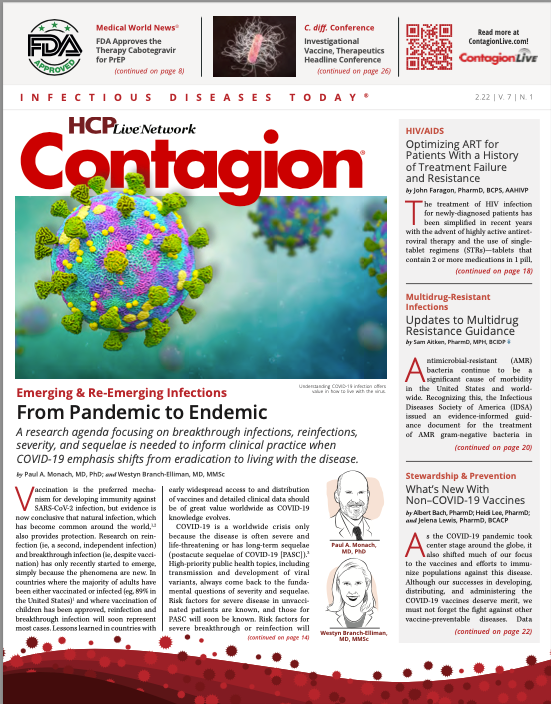Optimizing Antibiotic Use by Limiting Total Antibiotic Exposure
Shorter durations of antibiotic therapy demonstrate similar efficacy and may improve safety compared with longer courses for certain infections.
Antimicrobial stewardship is a coor-dinated program to optimize anti-microbial use, which includes evaluating duration of therapy. Infectious diseases organizations encourage strategies to reduce antimicrobial therapy to “the shortest effective duration.”1 Indeed, each additional day of antibiotic therapy has been associated with development of antimicrobial resistance and adverse drug events, including Clostridioides difficile infection.2,3 However, until recently, the most effective and safe durations of therapy for several common indications were not well defined, and historical recommendations were largely based on expert opinion (Table).

COMMUNITY-ACQUIRED PNEUMONIA
The 2019 American Thoracic Society and Infectious Diseases Society of America (IDSA) guidelines endorse 5 days of antibiotics for patients with community-acquired pneumonia (CAP) who are improving on therapy.4 The authors reference a randomized controlled trial (RCT) by el Moussaoui and colleagues that found 3 days of therapy with amoxicillin was noninferior to 8 days as part of the justification for a short course of treatment.5 However, study limitations including small sample size and broad exclusion criteria prevented widespread application of this approach—and even 5-day courses are not adhered to, especially at hospital discharge.6,7 In March 2021, another 3-day vs 8-day duration RCT (NCT01963442) for CAP was published, challenging the status quo.
This randomized, double-blind, noninferiority study included 303 adults with moderately severe CAP who were admitted to a medical ward and were clinically stable after 72 hours of empiric treatment.8 Stability was defined as temperature at or below 37.8 °C, heart rate less than 100 beats/min, respiratory rate less than 24 breaths/min, oxygen saturation at or greater than 90%, systolic blood pressure at or greater than 90 mm Hg, and normal mental status. Patients with severe or complicated CAP, known immunosuppression, possible aspiration pneumonia, or with health care–associated pneumonia were excluded. Baseline demographics were well balanced between groups, with most patients having an age greater than 65 years, 24% with at least 2 comorbidities, and median pneumonia severity index (PSI) score in class III (median 80.5 in short course vs 83.0 in long course). Three days was noninferior to 8 days in the primary outcome of clinical cure 15 days after start of treatment (77.0% vs 67.5%, respectively; 95% CI, –0.38 to 20.04). Furthermore, short courses remained noninferior regardless of age and PSI score in post hoc subgroup analyses.
The results of these 2 RCTs suggest a need to reevaluate the duration of therapy for patients with CAP who are improving on antibiotics. In patients with uncomplicated CAP who are clinically stable after 72 hours of effective therapy, further antibiotics may provide no additional benefit. The role of excessive antibiotic use and patient outcomes, specifically among patients with CAP, was explored by Vaughn et al in their retrospective cohort study conducted across 43 hospitals in Michigan.6 Among the study population, approximately two-thirds (67.8%) received a longer course of antibiotics compared with guideline-recommended durations (ie, 5 days), with a median excess duration of 2 days (IQR, 0-4 days). Each additional day of excessive antibiotic treatment was associated with 5% increased odds of a patient-reported adverse drug event.
Importantly, the Vaughn et al study also revealed over 90% of excessive antibiotic use occurred at the time of discharge. In fact, antibiotic overuse occurs frequently at discharge for pneumonia and other common infections.9 It is clear more attention should be focused on the interventions within the transitions of care space to reduce antibiotic misuse. However, implementing shorter antibiotic courses, such as 3 days for CAP, may allow for antibiotic discontinuation during hospital admission, thereby reducing the potential for excessive durations at the time of hospital discharge by eliminating the need for a discharge prescription.
UNCOMPLICATED GRAM-NEGATIVE BACTEREMIA
In 2019, Yahav et al conducted an RCT (NCT01737320) that demonstrated 7 days was noninferior to 14 days for treatment of uncomplicated gram-negative bloodstream infections.10 This landmark study was followed by another RCT (NCT03101072) in 2020 that compared 7-day, 14-day, and C-reactive protein (CRP)-guided treatment durations. In this study, a 7-day duration was noninferior to 14 days of therapy in the primary outcome of clinical failure at 30 days (6.6% vs 5.5%, respectively; 1-sided 97.5% CI, –infinity to 6.3; P < .001). CRP-guided treatment duration also had similar outcomes; median duration of therapy in this cohort was 7 days (IQR, 6-10 days).11 In September 2021, Molina et al also demonstrated similar outcomes in patients treated with 7 vs 14 days of therapy for uncomplicated Enterobacterales bloodstream infections.12 It is important to note that these data are primarily representative of patients with uncomplicated, monomicrobial Enterobacterales bacteremia from a urinary source. Patients with Pseudomonas aeruginosa bacteremia and/ or immune compromise are a minority of cases in these studies, thus limiting extrapolation of the findings. However, results from recent retrospective studies suggest short courses (ie, 7-9 days) may be appropriate for uncomplicated bacteremia due to P aeruginosa, as well.13,14
COMPLICATED URINARY TRACT INFECTION
Short courses of certain antibiotics (eg, 3-5 days) are standard care for patients with uncomplicated cystitis, whereas complicated urinary tract infections (UTIs) typically result in longer durations, although data are limited. UTIs in men are considered complicated by nature of the male anatomy and thus are commonly treated with a course between 7 and 14 days. In 2021, Drekonja et al challenged this practice with an RCT (NCT01994538) comparing 7 vs 14 days of antibiotics for afebrile men with clinical symptoms consistent with a UTI.15 Participants received either trimethoprim/sulfamethoxazole or ciprofloxacin at standard treatment dosing. Overall, 254 patients were included in the primary as-treated analysis (patients who missed ≥ 3 doses or > 2 consecutive doses were excluded). Among the as-treated population, 7 days was noninferior to 14 days in the primary outcome of resolution of UTI symptoms at day 14 post completion of treatment (93.1% vs 90.2%, respectively; 1-sided 97.5% CI, –5.2 to infinity). Additionally, recurrence of UTI symptoms was not significantly different between groups and rates of adverse effects were lower in the 7-day cohort (20.6%) compared with the 14-day group (24.3%). This study has several limitations including small sample size, inclusion of only 2 antibiotics for treatment option, and most importantly inclusion of patients without confirmed microbiological evidence of UTI and for whom antibiotics may have been inappropriately prescribed. These results should not be extrapolated to patients who meet other criteria for complicated UTI (eg, presence of urinary catheter, anatomic abnormality, etc), given a lack of data. However, it is advisable to implement shorter, 7-day courses in male patients who present without signs and symptoms of systemic infection.
DIABETIC FOOT OSTEOMYELITIS
Diabetic foot infections with bone and/ or joint involvement are usually treated with 4 to 6 weeks of antibiotics, per the IDSA guidelines.16 Gariani et al compared 3 vs 6 weeks of antibiotic therapy for patients with diabetic foot osteomyelitis after surgical debridement in a recent RCT (NCT03615807).17 Ninety-three patients were included in the study. Most were male (82%), 57% had osteomyelitis involving toe(s), and 37% had received partial amputation. Rates of remission were similar between 3-week vs 6-week groups in the intention-to-treat (ITT) population (84% vs 73% respectively, P = .21). Additionally, shorter courses were not associated with increased remission in multivariate analysis (ITT population, HR, 1.1; 95% CI, 0.6-1.7). Given the positive results of this trial, the study authors plan to proceed with an additional RCT with a larger cohort, and it is reasonable for clinicians to consider shorter courses of therapy in similar patients with surgical source control.
CONCLUSION
Historical recommendations for duration of therapy are largely based on expert opinion. As more RCTs are conducted in the infectious disease space regarding duration of therapy, high-quality evidence consistently guides us toward shorter courses. Limiting antibiotic exposure has a multitude of benefits for patients including similar efficacy, improved safety, optimized transitions of care, and decreased health care costs. Clinicians should make every effort to apply these studies’ findings in their routine practice to curb unnecessary antibiotic use and improve patient care.
References
- Barlam TF, Cosgrove SE, Abbo LM, et al. Implementing an antibiotic stewardship program: guidelines by the Infectious Diseases Society of America and the Society for Healthcare Epidemiology of America. Clin Infect Dis. 2016;62(10):e51-e77. doi:10.1093/cid/ciw118
- Teshome BF, Vouri SM, Hampton N, Kollef MH, Micek ST. Duration of exposure to antipseudomonal β-lactam antibiotics in the critically ill and development of new resistance. Pharmacotherapy. 2019;39(3):261-270. doi:10.1002/phar.2201
- Branch-Elliman W, O’Brien W, Strymish J, Itani K, Wyatt C, Gupta K. Association of duration and type of surgical prophylaxis with antimicrobial-associated adverse events. JAMA Surg. 2019;154(7):590-598. doi:10.1001/jamasurg.2019.0569
- Metlay JP, Waterer GW, Long AC, et al. Diagnosis and treatment of adults with community-acquired pneumonia. An official clinical practice guideline of the American Thoracic Society and Infectious Diseases Society of America. Am J Respir Crit Care Med. 2019;200(7):e45-e67. doi:10.1164/rccm.201908-1581ST
- el Moussaoui R, de Borgie CAJM, van den Broek P, et al. Effectiveness of discontinuing antibiotic treatment after three days versus eight days in mild to moderate-severe community acquired pneumonia: randomised, double blind study. BMJ. 2006;332(7554):1355. doi:10.1136/bmj.332.7554.1355
- Vaughn VM, Flanders SA, Snyder A, et al. Excess antibiotic treatment duration and adverse events in patients hospitalized with pneumonia: a multihospital cohort study. Ann Intern Med. 2019;171(3):153-163. doi:10.7326/M18-3640
- Dyer AP, Dodds Ashley E, Anderson DJ, et al. Total duration of antimicrobial therapy resulting from inpatient hospitalization. Infect Control Hosp Epidemiol. 2019;40(8):847-854. doi:10.1017/ice.2019.118
- Dinh A, Ropers J, Duran C, et al; Pneumonia Short Treatment (PTC) Study Group. Discontinuing β-lactam treatment after 3 days for patients with community-acquired pneumonia in non-critical care wards (PTC): a double-blind, randomised, placebo-controlled, non-inferiority trial. Lancet. 2021;397(10280):1195-1203. doi:10.1016/S0140-6736(21)00313-5
- Vaughn VM, Gandhi TN, Chopra V, et al. Antibiotic overuse after hospital discharge: a multi-hospital cohort study. Clin Infect Dis. 2021;73(11):e4499–e4506. doi:10.1093/cid/ciaa1372
- Yahav D, Franceschini E, Koppel F, et al; Bacteremia Duration Study Group. Seven versus 14 days of antibiotic therapy for uncomplicated gram-negative bacteremia: a noninferiority randomized controlled trial. Clin Infect Dis. 2019;69(7):1091-1098. doi:10.1093/cid/ciy1054
- von Dach E, Albrich WC, Brunel AS, et al. Effect of C-reactive protein–guided antibiotic treatment duration, 7-day treatment, or 14-day treatment on 30-day clinical failure rate in patients with uncomplicated gram-negative bacteremia: a randomized clinical trial. JAMA. 2020;323(21):2160-2169. doi:10.1001/jama.2020.6348
- Molina J, Montero-Mateos E, Praena-Segovia J, et al; SHORTEN trial team. Seven-versus 14-day course of antibiotics for the treatment of bloodstream infections by Enterobacterales: a randomized, controlled trial. Clin Microbiol Infect. Published online September 9, 2021. doi:10.1016/j.cmi.2021.09.001
- Fabre V, Amoah J, Cosgrove SE, Tamma PD. Antibiotic therapy for Pseudomonas aeruginosa bloodstream infections: how long is long enough? Clin Infect Dis. 2019;69(11):2011-2014. doi:10.1093/cid/ciz223
- Bae M, Jeong Y, Bae S, et al. Short versus prolonged courses of antimicrobial therapy for patients with uncomplicated Pseudomonas aeruginosa bloodstream infection: a retrospective study. J Antimicrob Chemother. 2021;77(1):223-228. doi:10.1093/jac/dkab358
- Drekonja DM, Trautner B, Amundson C, Kuskowski M, Johnson JR. Effect of 7 vs 14 days of antibiotic therapy on resolution of symptoms among afebrile men with urinary tract infection: a randomized clinical trial. JAMA. 2021;326(4):324-331. doi:10.1001/jama.2021.9899
- Lipsky BA, Berendt AR, Cornia PB, et al; Infectious Diseases Society of America. 2012 Infectious Diseases Society of America clinical practice guideline for the diagnosis and treatment of diabetic foot infections. Clin Infect Dis. 2012;54(12):e132-e173. doi:10.1093/cid/cis346
- Gariani K, Pham TT, Kressmann B, et al. Three weeks versus six weeks of antibiotic therapy for diabetic foot osteomyelitis: a prospective, randomized, noninferiority pilot trial. Clin Infect Dis. 2021;73(7):e1539-e1545. doi:10.1093/cid/ciaa1758

